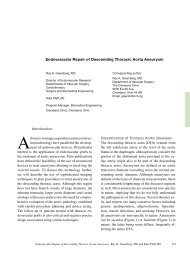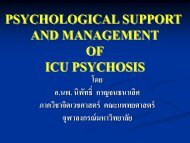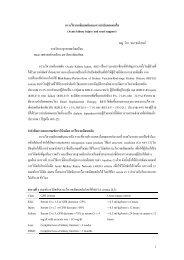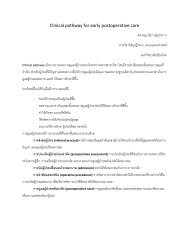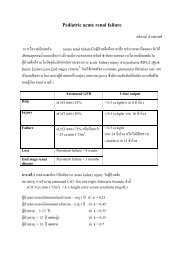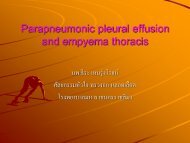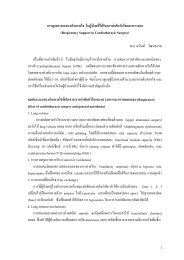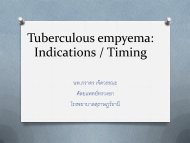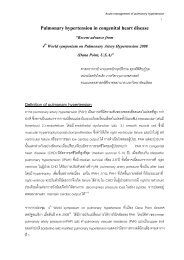You also want an ePaper? Increase the reach of your titles
YUMPU automatically turns print PDFs into web optimized ePapers that Google loves.
Which factors taken to beaccount <strong>in</strong> <strong>NSCLC</strong> treatment ?• 1. Stag<strong>in</strong>g• 2. ECOGperformance status• 3. Histology
Early stagePotentially resectablediseaseLocally advanced :unresectable diseaseMetastatic disease
Early stage (resectable disease)Adjuvant Chemotherapy beg<strong>in</strong> at stage IIA(IB +/- ; Category 2B)
Adjuvant Chemo <strong>in</strong> <strong>NSCLC</strong>; with what?Patient Regimen 1st Agent 2nd AgentFit,young - bestNPq 3 x 4V<strong>in</strong>orelb<strong>in</strong>e25-30 D1,8Cis75-80 D1Fit,young -alternativeEPq 3-4 x 4Etoposide100 D1-3Cis100 D1AcceptableregimenGCq 3 x 4Gem1250 D1,8Cis75 D1Pt withcomorbid, nottolerate cisTCarq 3 x 4Taxol200 D1CarboAUC 6 D1
Stage I,II,III(except IA)
Early stagePotentially resectablediseaseLocally advanced :unresectable diseaseMetastatic disease
Confirm pathologic N2 (if possible)
Early stagePotentially resectablediseaseLocally advanced :unresectable diseaseMetastatic disease
Which factors taken to beaccount <strong>in</strong> <strong>NSCLC</strong> treatment ?• 1. Stag<strong>in</strong>g• 2. ECOGperformance status• 3. Histology
American Society of Cl<strong>in</strong>icalOncology Cl<strong>in</strong>ical PracticeGuidel<strong>in</strong>e on CT for stage IV <strong>NSCLC</strong>Azzoli C, Baker S, Tem<strong>in</strong> S, et al. JCO 2009
First l<strong>in</strong>e treatment <strong>in</strong> <strong>NSCLC</strong>ASCODetailR A1 CT <strong>in</strong>dicate <strong>in</strong> ECOG 0,1 possibly 2R A2PS 0,1 = 2 drugs Plat<strong>in</strong>um preferredR A3 S<strong>in</strong>gle CT <strong>in</strong> PS 2R A4R A5R A6R A7R A8Not use age alone <strong>in</strong> decideEither Cis or Carbo are acceptable1 l<strong>in</strong>e should be stop at PD, or after 4 <strong>in</strong> NR1 l<strong>in</strong>e Gefit<strong>in</strong>ib may be for pt EGFR mutationBev + tax/carboplat<strong>in</strong> recommend except SCCR A9 Cet + V/C may consider <strong>in</strong> EGFR +
V 2012
Which factors taken to beaccount <strong>in</strong> <strong>NSCLC</strong> treatment ?• 1. Stag<strong>in</strong>g• 2. ECOGperformance status• 3. Histology
Histological type of <strong>NSCLC</strong>////
Which factors taken to beaccount <strong>in</strong> <strong>NSCLC</strong> treatment ?• 1. Stag<strong>in</strong>g• 2. ECOGperformance status• 3. Histology• Squamous cell carc<strong>in</strong>oma• Non-squamous cell carc<strong>in</strong>oma- Adenocarc<strong>in</strong>oma- Large cell carc<strong>in</strong>oma
Squamous histologyCl<strong>in</strong>ical Male,smokerCl<strong>in</strong>icalCentral,cavitationSmall cellSquamous cell CAMolecularRas and EGFR mutationrareHigh TS and EGFR overexpression common
Smoker adeno histologyNon smoker - adeno histologyCl<strong>in</strong>icalCl<strong>in</strong>icalMolecularMale,smokerPeripheral,pleural diseaseHigh ras mutation, EGFRover expression,low EGFR mutation, lowTSCl<strong>in</strong>icalCl<strong>in</strong>icalMolecularFemale, non smoker, asianPeripheral, multifocal,groundglass appearanceFrequent EGFR mutation, EGFRover expressionRas mutation rare, low TS
From pathologyto molecularbiology1. EGFR mutation + : EGFR-TKIs2. EGFR over expression : EGFR-Mob(cetuximab)3. EML4-ALK translocation : Crizot<strong>in</strong>ib
Systemic <strong>Treatment</strong> Options <strong>in</strong><strong>NSCLC</strong>•1. Standard doublet chemotherapy•2. Targeted therapy with EGFR-TKIs- Gefit<strong>in</strong>ib, Erlot<strong>in</strong>ib•3. Targeted therapy plus standard chemotherapy- Bevacizumab plus GC or TCar- Cetuximab plus VC
Limitation of 1 st l<strong>in</strong>e doublet CT <strong>in</strong> <strong>NSCLC</strong>Survival: ECOG 15941 st l<strong>in</strong>e 3 rd generation chemotherapy <strong>in</strong> <strong>NSCLC</strong>RR = 19 %TTP = 3.6 monthsMST = 7.9 months1 yr survival = 33%2 yr survival = 11%Schiller et al. NEJM 2002.
Does histology matter ...For the selection of CT <strong>in</strong> <strong>NSCLC</strong>
Squamous histologyCl<strong>in</strong>ical Male,smokerCl<strong>in</strong>icalCentral,cavitationSmall cellSquamous cell CAMolecularRas and EGFR mutationrareHigh TS and EGFR overexpression common
Smoker adeno histologyNon smoker - adeno histologyCl<strong>in</strong>icalCl<strong>in</strong>icalMolecularMale,smokerPeripheral,pleural diseaseHigh ras mutation, EGFRover expression,low EGFR mutation, lowTSCl<strong>in</strong>icalCl<strong>in</strong>icalMolecularFemale, non smoker, asianPeripheral, multifocal,groundglass appearanceFrequent EGFR mutation, EGFRover expressionRas mutation rare, low TSPemetrexed
CONSORT: Phase III Gemcitab<strong>in</strong>e orPemetrexed + Cisplat<strong>in</strong> as First-l<strong>in</strong>e TherapyAdvanced-stage,previously untreated<strong>NSCLC</strong> patients(N = 1725)Stratified by: ECOG PS (0 vs 1) Disease stage (IIIB vs IV) Bra<strong>in</strong> metastases (yes vs no) Sex (male vs female) Pathologic diagnosis (histologic vs cytologic) <strong>Treatment</strong> centerCisplat<strong>in</strong> 75 mg/m 2 on Day 1Gemcitab<strong>in</strong>e 1250 mg/m 2 on Days 1 and 8Six 3-wk cyclesCisplat<strong>in</strong> 75 mg/m 2 on Day 1Pemetrexed 500 mg/m 2 on Day 1Six 3-wk cyclesScagliotti GV, et al. J Cl<strong>in</strong> Oncol. 2008;26:3543-3551.
CONSORT: EfficacySurvivalMedian OS, mosPemetrexed+ Cisplat<strong>in</strong>(n = 862)10.3 10.3Gemcitab<strong>in</strong>e +Cisplat<strong>in</strong>(n = 863)HR(95% CI)0.94(0.84-1.05)P ValueNon<strong>in</strong>feriorAdenocarc<strong>in</strong>oma(N = 847)Large-cellcarc<strong>in</strong>oma(N = 153)Squamous cellcarc<strong>in</strong>oma(N = 473)12.6 10.910.4 6.79.4 10.80.84(0.71-0.99) .030.67(0.48-0.96) .031.23(1.00-1.51) .05Scagliotti GV, et al. J Cl<strong>in</strong> Oncol. 2008;26:3543-3551.
Targeted Therapy <strong>in</strong> <strong>NSCLC</strong>1. Target at tumor cells- over expression of EGFR : cetuximab- EGFR mutation : TKIs2. Target at vascular endothelial cells- Inc VEGF : anti-VEGF (bevacizumab )
EGFR expression <strong>in</strong> <strong>NSCLC</strong>xxxx
Proposed MoA of Bevacizumab: A dynamic effect throughout treatmentEARLY EFFECTSCONTINUED EFFECTS1 Regression 2 Normalization3 InhibitionDecreasestumour sizeImprovesdelivery ofCTxSuppresses new vesselgrowthSuppresses regrowthvia vessel ‘scaffolds’
Bevacizumab plus TCarb <strong>in</strong> non-squamous <strong>NSCLC</strong>E4599: OS1.00.90.80.70.60.50.40.30.20.10OS estimateOverall populationCP10.3 12.3Bevacizumab 15mg/kg + CP0 6 12 182430 36 42MonthsMedian OS (months)CP: 10.3Bevacizumab 15mg/kg + CP: 12.3HR=0.79; p=0.003OS estimateAdenocarc<strong>in</strong>oma*1.00.9CP0.8Bevacizumab 15mg/kg + CP0.70.60.50.40.30.20.1 10.3 14.200 6 12 182430 36 42 48MonthsMedian OS (months)CP: 10.3Bevacizumab 15mg/kg + CP: 14.2HR=0.691. Sandler, et al. NEJM 20062. Sandler, et al. JTO 2010 (<strong>in</strong> press)
Only PFS benefit <strong>in</strong> AVAiL(Bevacizumab+GC <strong>in</strong> non-squamous <strong>NSCLC</strong>)1.00.90.80.70.60.50.40.30.20.10PFS estimateE4599 1Bev 15mg/kg + CPCP0 6 1218 2430Time (months)1.00.90.80.70.60.50.40.30.20.10AVAiL 2Bev 7.5mg/kg + CGBev 15mg/kg + CGPlacebo + CG0 6 12 1824 30Time (months)Bevacizumab 15mg/kgBevacizumab 7.5mg/kgBevacizumab 15mg/kgMedian PFS6.2 vs 4.5 monthsHR=0.66; p
EGFR expression <strong>in</strong> <strong>NSCLC</strong>EGFR TKIsxxxx
Role of EGFR-TKIs <strong>in</strong> <strong>NSCLC</strong>Cl<strong>in</strong>ical selection- Female- Non smoker- Asian ethnicity- Adenocarc<strong>in</strong>oma histo
Role of EGFR-TKIs <strong>in</strong> <strong>NSCLC</strong>Cl<strong>in</strong>ical selectionMolecular selection- Female- Non smoker- EGFR mutation- EGFR amplification- Asian ethnicity- Adenocarc<strong>in</strong>oma histo
<strong>NSCLC</strong> patients with somatic mutation of EGFR havebeen shown to be hyperresponsive to the EGFR TKIsThe most common <strong>NSCLC</strong>-associated EGFR mutationsare– In-frame deletion <strong>in</strong> exon 19 (E746-A750del)– Po<strong>in</strong>t mutation <strong>in</strong> exon 21 (L858R)46%39%
Mutations <strong>in</strong> EGFR TK <strong>in</strong>Unselected Patients With <strong>NSCLC</strong>SubgroupTumorsScreened, nMutations Mean %(Range)United States 262 25 9 (2-14)Europe 860 39 5 (NR)Australia 83 6 7 (NR)Eastern Asia 1273 413 32 (26-40)Adenocarc<strong>in</strong>oma 907 245 27 (9-55)Other histology 837 9 1 (0-3)Men 865 108 12 (6-32)Women 369 143 38 (20-59)Smokers 662 66 10 (5-22)Nonsmokers 517 180 35 (12-69)Haber DA, et al. AACR 2005.
IPASS biomarkers study
At least 2 positive cl<strong>in</strong>ical factors(1 = Asean ethnicity)
V 2012
Overall survival (ITT population)Gefit<strong>in</strong>ib CBDCA/TXL(n=98) Logrank (n=100) testMedian survival 28.0 23.6 mHR (95%CI) 0.793 (0.485-1.296)p value* 0.354Overall survival (%)*Log-rank test2-year survival rateGefit<strong>in</strong>ib 61%CBDCA/TXL 45%Inoue et al. ECCO-ESMO 2009; Abstract 9LBA
Summary• Overall population• HRQoL endpo<strong>in</strong>ts were consistent with efficacy outcomes <strong>in</strong>IPASS• EGFR M+ population• Improvement rates <strong>in</strong> HRQoL and symptoms significantlyfavored gefit<strong>in</strong>ib over C/P• Times to worsen<strong>in</strong>g of HRQoL and symptoms were substantiallylonger for gefit<strong>in</strong>ib than C/P• Median time to improvement <strong>in</strong> HRQoL and symptoms were asrapid as 8 days with gefit<strong>in</strong>ib <strong>in</strong> patients who improved• EGFR M- population• Improvement rates <strong>in</strong> HRQoL and symptoms significantlyfavored C/P over gefit<strong>in</strong>ib• Times to worsen<strong>in</strong>g for HRQoL and symptoms were longer forC/P than gefit<strong>in</strong>ibThongprasert et al. ELCC 2010; Abstract 205O
EURTAC: First-l<strong>in</strong>e Erlot<strong>in</strong>ib vs Chemo <strong>in</strong> European PatientsWith EGFR Mutations174 patientsTrial run <strong>in</strong> Europe (lead by Spanish group)Outcome CT Erlot<strong>in</strong>ib HR P ValueResponse rate, % 15 58 - NRMedian PFS,mos5.2 9.7 0.37 < .0001Median OS, mos NR NR 0.80 .42Most commontoxicities, %ALT elevation: 72Anemia: 46Neutropenia: 36ALT elevation:80Rash: 80Diarrhea: 57Rosell R, et al. ASCO 2011. Abstract 7503.
Evidence based management decision for 1st l<strong>in</strong>e<strong>NSCLC</strong> good ECOGEGFR mutation +EGFR unknownSquamous CANon-squamousEGFR TKIsTraditional 3rd gendoublet CT(non-pemetrexed)Bev + doublet CTOrPem doublet CTOrTraditional CT
ASCO : RecommendationsECOG 0-1 :1 st -l<strong>in</strong>e plat<strong>in</strong>um doublet(4–6 cycles)ECOG 2 : s<strong>in</strong>gle agent CT“Wait andWatch policy”2nd-l<strong>in</strong>etreatmentDiagnosisCR,PR orSDPDPDWhen should 1 st l<strong>in</strong>e be stopped1. PD while on treatment2. After 4 cycles <strong>in</strong> patient whose disease is not respond<strong>in</strong>g to Px (SD)3. 2 drug comb<strong>in</strong>ations should be adm<strong>in</strong>istered for no more than 6cyclesAmerican Society of Cl<strong>in</strong>ical Oncology CPG update onchemotherapy for stage IV <strong>NSCLC</strong>. JCO 2009.
Second l<strong>in</strong>e treatment <strong>in</strong> Advanced <strong>NSCLC</strong>BSC Docetaxel Pemetrexed Erlot<strong>in</strong>ib2000 2004 2005
2004: pemetrexed versus docetaxel –efficacy and tolerability1.00D(n=276)P(n=265)Median OS (mos) 7.9 8.3Variable Pemetrexed Docetaxel p-valueOverall response (%) 9.1 8.8 NSProgression-free survival, median(mos)2.9 2.9 NSTime to progression, median (mos) 3.4 3.5 NS0.751-yr survival (%) 29.7 29.7Duration of response,median (mos)4.6 5.3 NSOS probability0.500.250PemetrexedDocetaxelHR=0.99 (0.8–1.2)Survival time, median (mos) 8.3 7.9 NS1-year survival rate (%) 29.7 29.7 NSNeutropenia grade 3–4 (%) 5.3 40.2
2005: erlot<strong>in</strong>ib showed OS advantage <strong>in</strong> pre-treated<strong>NSCLC</strong> (BR.21)1.00Erlot<strong>in</strong>ib(n=488)Placebo(n=243)0.75Median OS (months) 6.7 4.7OS probability0.500.25HR=0.73 (0.60–0.87), p=0.001*00 5 10 1520 2530Time (months)Shepherd, et al. NEJM 2005
Second l<strong>in</strong>e treatment <strong>in</strong> Advanced <strong>NSCLC</strong>Gefit<strong>in</strong>ib ?BSC Docetaxel Pemetrexed Erlot<strong>in</strong>ib2000 2004 2005
Ma<strong>in</strong>tenance TherapyEmerg<strong>in</strong>g Approach <strong>in</strong> <strong>NSCLC</strong>HistoricalapproachFirst-l<strong>in</strong>e treatmentPlat<strong>in</strong>um doubletchemotherapy(4–6 cycles)‘Watch andwait’Second andfurther l<strong>in</strong>esof treatmentDiagnosisCR/PR/SDPDPDIncreasedtime to PDNewapproachMa<strong>in</strong>tenance therapyDiagnosis CR/PR/SD PD PD
Summary of available cl<strong>in</strong>ical evidences of“Ma<strong>in</strong>tenance therapy”• 1. Ma<strong>in</strong>tenance therapy with same drug : Cont<strong>in</strong>uation1.1 Gem after GC x 41.2 Gem or Erlot<strong>in</strong>ib after GC x 4• 2. Ma<strong>in</strong>tenance therapy with different drug : Switch<strong>in</strong>g2.2 Doc after GC x 42.1 Pem after GC x 4 (JMEN)2.2 Erlot<strong>in</strong>ib after GC x 4 (SATURN)• 3. Ma<strong>in</strong>tenance therapy with “Both”3.1 Bev + Erlot<strong>in</strong>ib after Bev + CT (ATLAS)
JMEN (ma<strong>in</strong>tenance pemetrexed):PFS and OS <strong>in</strong> ITT populationPatients with stage IIIB/IV<strong>NSCLC</strong> and PS 0–1 who hadreceived 4 previous cycles ofgemcitab<strong>in</strong>e, docetaxel, orpaclitaxel + plat<strong>in</strong>um with CR, PR,or SD (n=663)RANDOMISE2:1Pemetrexed 500mg/m 2 on d1q21d + BSC(n=441)Placebo on d1 q21d + BSC(n=222)PFS probability1.00.80.60.40.2PemetrexedPlaceboHR=0.60 (95% CI 0.49–0.73);p
Ma<strong>in</strong>tenance Pemetrexed : DFSBenefit of non-squamous histologyCiuleanu et al. Lancet 2009.
Evidence base systemic treatment<strong>in</strong> <strong>NSCLC</strong> stage IV
1st L<strong>in</strong>e
1st L<strong>in</strong>e2nd L<strong>in</strong>e Doublet ChemotherapyTCarbPemCisGC(Adenocarc<strong>in</strong>oma)3rd L<strong>in</strong>ePemetrexedDocetaxel4th L<strong>in</strong>eAYCAYC
1st L<strong>in</strong>e2nd L<strong>in</strong>e Docetaxel Docetaxel
1st L<strong>in</strong>e2nd L<strong>in</strong>eDocetaxelDocetaxel3rd L<strong>in</strong>eEGFR-TKIsEGFR-TKIs




